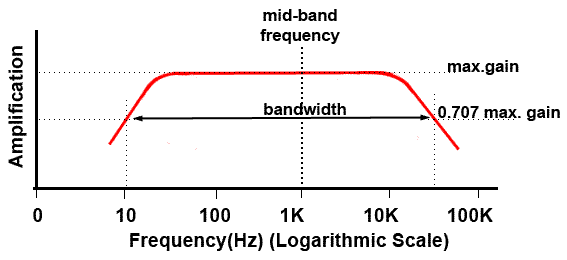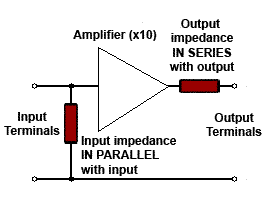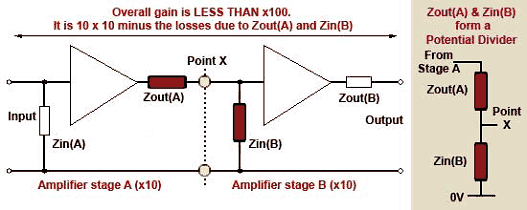friends today we shall learn about basics of impedence usefull for learning about rc coupled amplifier
Fig 7.2.1 Defining the Impedance Frequency.

The component or circuit will not have the same impedance at all frequencies. It is common for inputs and outputs on many types of equipment to have their impedances quoted in Ohms and to assume a common frequency for that particular type of equipment. For example, audio commonly uses a frequency of 1kHz as the standard for measuring impedance. This is because 1kHz is approximately the centre of an audio amplifier´s bandwidth, measured on a logarithmic scale, as shown in Fig 7.2.1. The thing to notice in equipment designed to interconnect with other units is that most inputs (to amplifiers etc) have high impedances (in Ohms) whereas outputs have much lower impedances. The reason for this is because of the effects of impedance.
Fig 7.2.2 Input and Output Impedances

An amplifier can be considered to have two impedances that affect the way it can be connected to other amplifiers, one impedance is considered to be connected across the input terminals (because when an input source is connected to these terminals, a current flows across the terminals, therefore, there must be an impedance (shown as a resistor) for the current to flow through. At the output there is another imaginary resistor (impedance), this time connected in series with the flow of current. The effect of this output impedance is to reduce the voltage at the output terminals, and the more current drawn from the output, the more the terminal voltage is reduced, therefore there must be an (invisible) resistance across which the voltage is being dropped. The input and output impedances of an amplifier are illustrated in Fig 7.2.2
Fig. 7.2.3 Matching Input and Output Impedances.

Impedance matching of inputs and outputs is necessary because the gain of a single amplifier is often insufficient for a given purpose. For this reason several stages of amplification are used, which involves feeding the output of one amplifier into the input of another. This is called connecting the amplifiers in "Cascade". It is then important that the output impedance of the first amplifier and the input impedance of the second amplifier form a potential divider as shown in Fig 7.2.3.
If the amplifiers are voltage amplifiers, i.e. amplifier stages whose voltage gain is greater than either their current or power gains, the voltage waveform needs to be coupled from one stage to the next with as little reduction in amplitude as possible. Notice that the output impedance of the first stage and the input impedance of the second stage form a
potential divider, and the voltage available at the junction of the two impedances will depend on the relative values of Z
in (B) to Z
out (A). The higher the value of an impedance, the more voltage will be developed across it for a given current flow. Provided that Z
in (B) is much greater than Z
out (A), the majority of the available voltage at point X (the input to stage B) will be developed across its input impedance Z
in (B), and so across stage B input terminals rather than across the first amplifier´s output impedance.
In the case of power amplifiers, the maximum power is transferred from output to input if both impedances are the same.
The values of input and output impedance have a considerable effect on the gain of multi stage amplifiers and there is always some loss of signal amplitude that occurs due to the coupling of successive amplifier stages. In calculating the overall gain of a multi stage amplifier, the overall gain is equal to the product of the individual gains of each amplifier. i.e if each stage of a two stage amplifier has a gain of 10, then the overall gain should be 10 x 10 = 100. In practice however, this is not achievable due to the coupling losses incurred in matching the amplifiers, and a slightly lower gain results. The
value of input and output impedance can be arranged to an appropriate value by the choice of amplifier design.
Although the above description refers to coupling amplifiers together, the same considerations apply when an amplifier is driving a power device such as a loudspeaker, a current operated device such as a motor, or in matching an input device such as a microphone to the input of a voltage amplifier.
 This wild new motorcycle, invented by 19-year-old Ben J. Poss Gulak, is among the latest inventions to capture attention. Debuting at the National Motorcycle Show in Toronto, the "Uno" uses gyro technology for balance and acceleration.
This wild new motorcycle, invented by 19-year-old Ben J. Poss Gulak, is among the latest inventions to capture attention. Debuting at the National Motorcycle Show in Toronto, the "Uno" uses gyro technology for balance and acceleration. The component or circuit will not have the same impedance at all frequencies. It is common for inputs and outputs on many types of equipment to have their impedances quoted in Ohms and to assume a common frequency for that particular type of equipment. For example, audio commonly uses a frequency of 1kHz as the standard for measuring impedance. This is because 1kHz is approximately the centre of an audio amplifier´s bandwidth, measured on a logarithmic scale, as shown in Fig 7.2.1. The thing to notice in equipment designed to interconnect with other units is that most inputs (to amplifiers etc) have high impedances (in Ohms) whereas outputs have much lower impedances. The reason for this is because of the effects of impedance.
The component or circuit will not have the same impedance at all frequencies. It is common for inputs and outputs on many types of equipment to have their impedances quoted in Ohms and to assume a common frequency for that particular type of equipment. For example, audio commonly uses a frequency of 1kHz as the standard for measuring impedance. This is because 1kHz is approximately the centre of an audio amplifier´s bandwidth, measured on a logarithmic scale, as shown in Fig 7.2.1. The thing to notice in equipment designed to interconnect with other units is that most inputs (to amplifiers etc) have high impedances (in Ohms) whereas outputs have much lower impedances. The reason for this is because of the effects of impedance. An amplifier can be considered to have two impedances that affect the way it can be connected to other amplifiers, one impedance is considered to be connected across the input terminals (because when an input source is connected to these terminals, a current flows across the terminals, therefore, there must be an impedance (shown as a resistor) for the current to flow through. At the output there is another imaginary resistor (impedance), this time connected in series with the flow of current. The effect of this output impedance is to reduce the voltage at the output terminals, and the more current drawn from the output, the more the terminal voltage is reduced, therefore there must be an (invisible) resistance across which the voltage is being dropped. The input and output impedances of an amplifier are illustrated in Fig 7.2.2
An amplifier can be considered to have two impedances that affect the way it can be connected to other amplifiers, one impedance is considered to be connected across the input terminals (because when an input source is connected to these terminals, a current flows across the terminals, therefore, there must be an impedance (shown as a resistor) for the current to flow through. At the output there is another imaginary resistor (impedance), this time connected in series with the flow of current. The effect of this output impedance is to reduce the voltage at the output terminals, and the more current drawn from the output, the more the terminal voltage is reduced, therefore there must be an (invisible) resistance across which the voltage is being dropped. The input and output impedances of an amplifier are illustrated in Fig 7.2.2 Impedance matching of inputs and outputs is necessary because the gain of a single amplifier is often insufficient for a given purpose. For this reason several stages of amplification are used, which involves feeding the output of one amplifier into the input of another. This is called connecting the amplifiers in "Cascade". It is then important that the output impedance of the first amplifier and the input impedance of the second amplifier form a potential divider as shown in Fig 7.2.3.
Impedance matching of inputs and outputs is necessary because the gain of a single amplifier is often insufficient for a given purpose. For this reason several stages of amplification are used, which involves feeding the output of one amplifier into the input of another. This is called connecting the amplifiers in "Cascade". It is then important that the output impedance of the first amplifier and the input impedance of the second amplifier form a potential divider as shown in Fig 7.2.3.